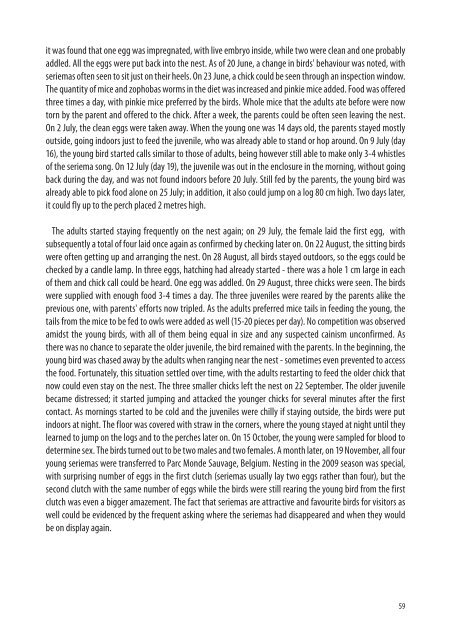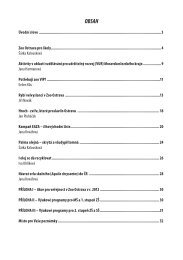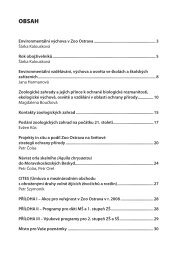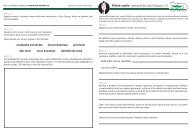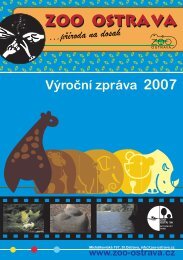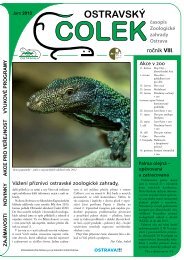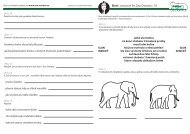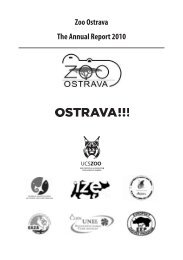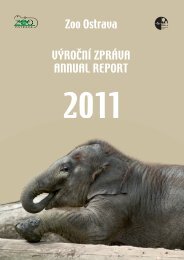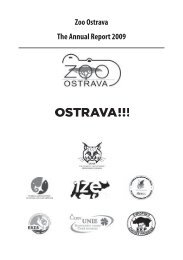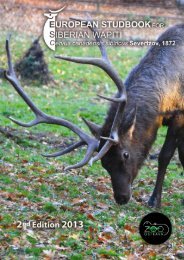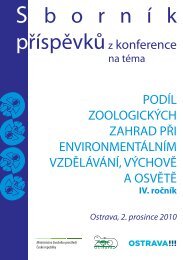58Baby boom in red-crested seriemasSylva FirlováSeriemas - distinctive and intriguing alike their name. Derived from native words seri - "the small", andema - "nandu", which is the rhea in Spanish, this means a small rhea if both words are combined. The scientificname of the genus, Cariama, is also of native origin, meaning "the one who features a crest".The red-crested seriema (Cariama cristata) is one of two members of the Cariamidae family placed in theGruiformes order, with bustards being the closest relatives. They are slender-bodied birds that stand 75-90cm. Brown in colour, with lightish underparts, they feature a long and banded tail and a striking erectilecrest on the head. The skin around their eyes is naked and bluish, beaks and legs are red. Both sexes are ofthe same colour. Fossils of seriema predecessors were found in the American continent as well as in Europe.The ancestors of the seriema were 1 to 3 metres tall. Nowadays, the seriema ranges across vast areas in SouthAmerica from central and eastern Brazil through eastern Bolivia and Paraguay as far as Uruguay and centralArgentina. They dwell in open grasslands and sparse bush areas, known to live mostly as single birds, butalso in pairs and families. They call very often, featuring a high-pitched voice that can be heard over a longdistance. Despite being omnivorous creatures, they prefer insects - locusts and beetles, also hunting for smallrodents, slugs, snails and lizards; occasionally, they take snakes. Tree-nesting birds, they place their nest oneto five metres high. It is built by both partners, with materials used including branches, grass, leaves and sods.Normally, the female will lay two eggs. Following 27-28 days of incubation, chicks hatch and are attended byboth parents.<strong>Ostrava</strong> <strong>Zoo</strong> has been keeping seriemas since 2007, when a male yearling was imported, followed bya young female in October 2008, both originating from Pilsen <strong>Zoo</strong>. In the main season, seriemas could beseen by visitors in large birds of prey aviaries in a mixed exhibit with king vultures. Prior the winter, the birdswere relocated to the wintering facility, where they were placed in a room 6 by 5 metres large furnished withdead trees, perches, elevated platforms and a parapet 40 cm wide in the window height. Further, they couldaccess a 10x4m outdoor aviary adjoining the room during the day. This facility was shared with two male kingvultures and two female American black vultures. After a month, one of the king vultures started chasing theseriema male, so all king vultures were moved away.In mid March <strong>2009</strong>, the seriema pair began calling, often together. A change in behaviour indicated a nearingmating season. In early April, the black vultures were relocated as well and several nesting opportunitiesprepared: a 1x1m elevated platform in the height of 2.5 metres, a 1x1m box elevated 0.5 m and a vegetablecarrier box placed 1.5 m high. Each nesting item was equipped with straw and hay, with additional nestingmaterials like straw, hay, twigs, sods and grass made available on the floor. Holding the birds only indoorsat night was stopped and the outdoor enclosure was available night and day. In early May, seriemas oftenstayed on the upper platform. Due to a small quantity of nesting materials brought by the birds (just littlepieces of grass and twigs), straw and hay was added every other day. Mating was not observed, with justone mating attempt on 30 April. The birds sat on the nest on 18 May, taking turns in brooding. A check madeday later assured the team there was one egg on the nest, with another laid by the female on 20 May. On <strong>12</strong>June, the team managed to find seriemas out of the nest, seeing there were already four eggs. Using a lamp
it was found that one egg was impregnated, with live embryo inside, while two were clean and one probablyaddled. All the eggs were put back into the nest. As of 20 June, a change in birds' behaviour was noted, withseriemas often seen to sit just on their heels. On 23 June, a chick could be seen through an inspection window.The quantity of mice and zophobas worms in the diet was increased and pinkie mice added. Food was offeredthree times a day, with pinkie mice preferred by the birds. Whole mice that the adults ate before were nowtorn by the parent and offered to the chick. After a week, the parents could be often seen leaving the nest.On 2 July, the clean eggs were taken away. When the young one was 14 days old, the parents stayed mostlyoutside, going indoors just to feed the juvenile, who was already able to stand or hop around. On 9 July (day16), the young bird started calls similar to those of adults, being however still able to make only 3-4 whistlesof the seriema song. On <strong>12</strong> July (day 19), the juvenile was out in the enclosure in the morning, without goingback during the day, and was not found indoors before 20 July. Still fed by the parents, the young bird wasalready able to pick food alone on 25 July; in addition, it also could jump on a log 80 cm high. Two days later,it could fly up to the perch placed 2 metres high.The adults started staying frequently on the nest again; on 29 July, the female laid the first egg, withsubsequently a total of four laid once again as confirmed by checking later on. On 22 August, the sitting birdswere often getting up and arranging the nest. On 28 August, all birds stayed outdoors, so the eggs could bechecked by a candle lamp. In three eggs, hatching had already started - there was a hole 1 cm large in eachof them and chick call could be heard. One egg was addled. On 29 August, three chicks were seen. The birdswere supplied with enough food 3-4 times a day. The three juveniles were reared by the parents alike theprevious one, with parents' efforts now tripled. As the adults preferred mice tails in feeding the young, thetails from the mice to be fed to owls were added as well (15-20 pieces per day). No competition was observedamidst the young birds, with all of them being equal in size and any suspected cainism unconfirmed. Asthere was no chance to separate the older juvenile, the bird remained with the parents. In the beginning, theyoung bird was chased away by the adults when ranging near the nest - sometimes even prevented to accessthe food. Fortunately, this situation settled over time, with the adults restarting to feed the older chick thatnow could even stay on the nest. The three smaller chicks left the nest on 22 September. The older juvenilebecame distressed; it started jumping and attacked the younger chicks for several minutes after the firstcontact. As mornings started to be cold and the juveniles were chilly if staying outside, the birds were putindoors at night. The floor was covered with straw in the corners, where the young stayed at night until theylearned to jump on the logs and to the perches later on. On 15 October, the young were sampled for blood todetermine sex. The birds turned out to be two males and two females. A month later, on 19 November, all fouryoung seriemas were transferred to Parc Monde Sauvage, Belgium. Nesting in the <strong>2009</strong> season was special,with surprising number of eggs in the first clutch (seriemas usually lay two eggs rather than four), but thesecond clutch with the same number of eggs while the birds were still rearing the young bird from the firstclutch was even a bigger amazement. The fact that seriemas are attractive and favourite birds for visitors aswell could be evidenced by the frequent asking where the seriemas had disappeared and when they wouldbe on display again.59
- Page 2 and 3:
Provozovatel zoo: Zoologická zahra
- Page 5 and 6:
ObsahÚvodní slovo ředitelePetr
- Page 7 and 8:
Vážení příznivci Zoo Ostrava,d
- Page 9 and 10:
Stavy chovaných zvířatChov zví
- Page 12 and 13:
pečovaly o mláďata z roku předc
- Page 15 and 16:
2) z účelově vázaného přísp
- Page 17 and 18:
Rok 2009 byl pro naši organizaci v
- Page 19 and 20:
Výnosy v roce 2009v tis.Kč% změn
- Page 21 and 22:
Osobní náklady tj. vlastní mzdy,
- Page 23 and 24:
Výstavba, projektová činnost a
- Page 25 and 26:
Z dalších změn v areálu zoo sto
- Page 27 and 28:
• byla dokončena projektová př
- Page 29 and 30:
Vzdělávací a propagační činno
- Page 31 and 32:
• 25.7. Když si zvířata hrají
- Page 33 and 34:
Činnost dendrologického oddělen
- Page 35 and 36:
Pozorování a sběr údajů o zví
- Page 37 and 38:
Rok šelem v Zoo OstravaMonika Ondr
- Page 39 and 40:
Historický nárůst počtu chovan
- Page 41 and 42:
Chov nového druhu primáta v Zoo O
- Page 43 and 44:
akovinným bujením, které zapří
- Page 45 and 46:
Odchov supa hnědého v Zoo Ostrava
- Page 47 and 48:
Repatriace supa hnědého a orlosup
- Page 49 and 50:
ještě před vylétnutím a jejich
- Page 51 and 52:
Odchov ohrožených druhů papoušk
- Page 53 and 54:
tuto budku přijali. Opět si vytvo
- Page 55 and 56:
pobývali většinou venku, mládě
- Page 57 and 58:
Novinky u slonůPavel ZvolánekRok
- Page 59 and 60:
při průchodu porodními cestami,
- Page 61 and 62:
Róze se poslední mládě narodilo
- Page 63 and 64:
Návrat orla skalního (Aquila chry
- Page 65 and 66:
Seznam zaměstnanců Zoo Ostrava (k
- Page 67 and 68:
Jméno Funkce Počet let v org.62 P
- Page 69 and 70:
Druh (poddruh)Species (subspecies)S
- Page 71 and 72:
Druh (poddruh)Species (subspecies)S
- Page 73 and 74:
Druh (poddruh)Species (subspecies)S
- Page 75 and 76:
Druh (poddruh)Species (subspecies)S
- Page 77 and 78:
Druh (poddruh)Species (subspecies)S
- Page 79 and 80:
Druh (poddruh)Species (subspecies)S
- Page 81 and 82:
Druh (poddruh)Species (subspecies)S
- Page 83 and 84:
Druh (poddruh)Species (subspecies)S
- Page 85 and 86:
Druh (poddruh)Species (subspecies)S
- Page 87 and 88:
Druh (poddruh)Species (subspecies)S
- Page 89 and 90:
Druh (poddruh)Species (subspecies)S
- Page 91 and 92:
Druh (poddruh)Species (subspecies)M
- Page 93 and 94:
FormaFormazajícovci (Lagomorpha)St
- Page 95 and 96:
▲ Nejvzácnější přírůstek r
- Page 97 and 98:
▲ Úprava vnitřních prostor v p
- Page 99 and 100:
▲ Odběr spermatu u samce slona i
- Page 101 and 102:
◀ Nový druh v Zoo Ostrava - peli
- Page 103 and 104:
▶ Pohlednice u voliéry supů hn
- Page 105 and 106:
◀ Google v zoo při sběru datpro
- Page 108 and 109:
Zoological Garden OstravaAddress: Z
- Page 111 and 112:
ContentsDirector´s introductory wo
- Page 113 and 114:
Dear friends,Ostrava Zoo is coming
- Page 115 and 116: Animal numbersAnimal collection in
- Page 117 and 118: of which a member of the very rare
- Page 119 and 120: success refers to the offspring pro
- Page 121 and 122: The founder’s non-capital funding
- Page 123 and 124: 3) CZK 737 thousand allocated to re
- Page 125 and 126: To co-fund 46.4% from the operating
- Page 127 and 128: As regards cost items in 2009, only
- Page 129 and 130: namely tiger enclosures, hoofed mam
- Page 131 and 132: Design, development and maintenance
- Page 133 and 134: This operation was supported by the
- Page 135 and 136: • Development of the building app
- Page 137 and 138: Ostrava Zoo - the zoo office and ma
- Page 139 and 140: Again, the event was co-funded by t
- Page 141 and 142: and involved models of a turtle she
- Page 143 and 144: Activities of the Horticulture Depa
- Page 145 and 146: and it was carried out by the scien
- Page 147 and 148: A year of carnivores at Ostrava Zoo
- Page 149 and 150: Historical increase in the number o
- Page 151 and 152: Keeping a new primate species at Os
- Page 153 and 154: for the lemurs, where the family of
- Page 155 and 156: Month 8 Beira's climbing the ropes
- Page 157 and 158: as the birds changed over on 28 Apr
- Page 159 and 160: • Birds of prey are rather slow i
- Page 161 and 162: Monitoring nests of endangered bird
- Page 163 and 164: The yellow cardinal at Ostrava ZooY
- Page 165: a bowl with fresh water multiple ti
- Page 169 and 170: eginnings when the young are fed by
- Page 171 and 172: The way the bull was handled within
- Page 173 and 174: Keeping the common hippopotamus (Hi
- Page 175 and 176: Studbook # /nameSexDate ofbirthDam/
- Page 177 and 178: General summaryThanks to the projec
- Page 179 and 180: NamePositionNumber of yearsin the o


